
without permission. © 2006-2022 - All Rights Reserved
We will bore you to tears with some warbler talk, and if or when you can't take it, just scroll through the pictures. :) What good is a warbler? You might not notice them much but if you removed them you would sure see and feel the difference. This is what they do all year:

Nashville Warbler doing what warblers do best (it ain't warblin'!),
eating 'worms', caterpillars that is... (digiscope image)
I imagine they take a fair number of skeeters too.
Around the world there are various types of birds called warblers, which are not all in one family group of birds. The warblers found in America are properly called Wood-Warblers. But being pressed for time as we are, they are just called warblers by American birders. Warblers are many people's favorite birds. Stunning beauty, fast action, endless variety, amazing lives, most with long migrations, and in fall, identification challenges. They have it all. Except a good warble. Most don't really warble very well (a couple do), but their songs are favorites, each species usually with A and B songs, plus a selection of call notes... imagine 55 chip notes to learn! How exciting can it get!?! Each chip slightly different in its own special way, when learned may offer the best most diagnostic field mark one could ask for. The thrill of it all!
Here we'll show some of the species you can find around Utopia. About 40 of North America's 55 species are known from the upper Sabinal River drainage area. Lost Maples to Clayton Grade, centered by Utopia. Only about half, 20 species and change, occur locally in any given year, if you are lucky. Most of the photos here concentrate on showing those 20 or so more common types you are most likely to see. I have seen 36 species (plus Audubon's) at Utopia Park (in 18 yrs.). With its 30 years of spring birder coverage Lost Maples shows 33 species of warblers on its list. Though note nearly HALF of them (15) have been seen only once or twice, they are accidental, less than 20 species are reported annually there. The flip side is the most common nesting warbler there is Golden-cheeked.
This is a common viewing angle when warbler watching,
of the Edwards Plateau's flagship endemic warbler.

Golden-cheeked Warbler - note entire posterior abdomen below is
pure snow white: flanks, around legs and vent area, everything.
Black-throated Green always shows olive or yellow tints in this area.
The worn pointed rectrices (tail feathers) and worn brown primaries
(wing feathers (as backlit tip of right wing)) mean first summer bird.
It was prepping a morsel for consumption. This can be a very dangerous
risky angle for attempting bird photography.
Most of the warbler diversity here is migrants, and that is far better in spring than fall. Only a handful of types breed here, and very few types winter here. The biggest single day diversity I had here was a late season cold front on May 2, 2011, with 21 species around Utopia, most at the park. That is a once in 15-20 years or more event, any day you find 10 species of warblers locally here ya done real good. For me, being here listening every day and looking a few days a week, over 15 years, my spring averages about 16 species over the passage, fall about 13.5 species. One spring (2011) I saw 30 species locally.
Note there is a Utopia Park birdlist page, amongst which is that site's warbler list. There is also a page with a the whole local area birdlist (Utopia and vicinity) in which all the warblers known locally (upper Sabinal River drainage) are listed. On both lists status is given for each species, often with frequency of occurrence or dates for rarity records. Here are the links:
Birds of Utopia Park
Birds of Utopia
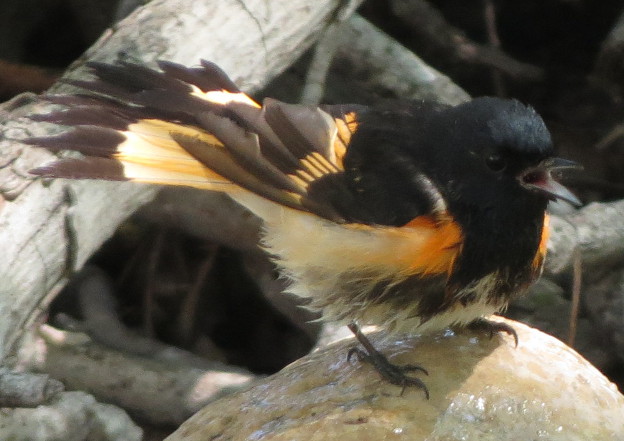
This is a male American Redstart, which flicks and flashes the wings
and tail, and colors, constantly, in an exaggerated showy fashion.
Females and immatures are gray and yellow (one is shown below).
Now about these warblers...
First, we are going to show the most common warbler in Utopia, even seen by virtually all non-birders. This is of course the Yellow-rumped Warbler. Small numbers winter around town and can be seen in most yards. They have a soft chip note call they give regularly. There are two types, subspecies now, formerly separate species. The eastern Myrtle type (white throat) is most of what we have, a few of the western Audubon's type (yellow throat) are often around, as well as the occasional (regular - annual) hybrid or intergrade. Myrtles are present from mid-late October to March, passage migrants occur in April, when often in breeding plumage. The overwhelming majority of wintering Myrtle here are males. They are often in the streets eating run-over pecans in Nov. and December. I generally call them by which type they are when I hear (basic chip notes different) or see them, Myrtle, or Audubon's Warbler. When I don't get a good enough look or hear it call, I use Yellow-rumped Warbler. They should be re-split back into separate species IMHO. They were one of many victims of the over-zealous 1970's species lumping craze.
Winter Yellow-rumped Warbler:

A winter plumaged Myrtle (Yellow-rumped) Warbler. Some have yellow
patches on the side of breast (esp. adult male) and all have a bright
yellow patch on the rump obvious when they fly away.

Here is the yellow rump it is named for.
Myrtles have a white throat.

Here is an Audubon's type in fall, note yellow throat.
A few pass through in late September, weeks ahead of Myrtle
arrival which is mid-October or later. Some years one or a
few winter locally with the Myrtles.
Yellow-rumped Warbler is the warbler everyone knows, even those that don't even know they knew a warbler. Fairly tame and confiding, since everyone sees them several months of the year in their yards, I figured covering it a bit first gives some warbler frame-of-reference for those that are not (yet) warbler nuts. Like the rest of us.
~ ~ ~
We are going to look at Utopia warblers, seasonally.
BREEDERS
We only have a few nesting species of warblers locally, 4 regular annual breeders (so not counting Chat since no longer a warbler). Then there are three 3 species of irregular scarce toe-holder colonists (2 are from Mexico) that are trying to breed, and maybe or probably they are. In general our regular breeders arrive early, usually about mid-March, and depart early, often in June and July you can see them heading out and south, often down the river habitat corridor (Golden-cheeks stay up on the divides more).
Of course most have at least heard of the Edwards Plateau and hill country premier headliner, the Golden-cheeked Warbler due to its endangered (threatened) status. Though widespread locally, it is very micro-habitat specific and best seen at Lost Maples SNA. Seeable mid-March through June, though some present through July, a very few to early August. They can be fickle later in season. It has its own page of photos and discussion.
Golden-cheeked Warbler

Golden-cheeked Warbler, the Edwards Plateau's most endemic
bird species, it breeds nowhere else. The female makes the nest
almost completely out of the peeling bark of the Ashe Juniper,
so which is a little cedar chest cup.
Besides Golden-cheeked, other warblers nesting there (Lost Maples) and other headwater stream habitats locally like Big Springs over the divide from Maples at Frio River headwaters, are Louisiana Waterthrush, and Black-and-white Warbler. Some Black-and-whites nest along Sabinal River (and Frio) where extensive mixed deciduous patches. The waterthrush only nests where fast moving water. Then anywhere along the big rivers in the area in tall Cypress trees there are nesting Yellow-throated Warbler. They also nest in live-oak mottes, even away from water, if and when infested with ball moss, and have colonized these in Lost Maples in the last 10 years or so. These are of a vocally distinct flavor, and ball moss specialist here. Edwardsplateauensis I call it. There is some more detailed discussion of it at the end of this piece. So Golden-cheeked, Black-and-White, and Yellow-throated Warbler, plus Louisiana Waterthrush, are our four species of regular nesting species of warblers locally. Then there is the former warbler, Yellow-breasted Chat, which also nests, but is not a warbler.

Yellow-throated Warbler, September 27.
Louisiana Waterthrush is fairly restricted to headwater habitats here. I suspect in some areas where River narrows to stream, it might nest away from Lost Maples, as well as along any feeder streams with permanent water. Like Little or Seco Creek, Rio Hondo, etc., for instance. The Black-and-white Warbler is more widespread and just requires some mixed deciduous woods of size. Besides at Lost Maples it also nests along Sabinal River on valley floor, where enough mixed deciduous trees. It needs more than an acre of woods though as evidenced by them not nesting at Utopia Park in that acre of mixed woods. In areas of just Cypress, they will not be there as a breeder. The Golden-cheeked is virtually always on sloped ground with a terrestrial gradient, with Ashe Juniper and Buckley and or Lacey Oak. Each warbler exploits its own particular niche. The waterthrush at waters edge and down on the ground, the Black-and-white on the bark of trunks and big branches, the Golden-cheeked gleans foilage at the tips of branches and the Yellow-throated loves bigger branches and ball moss. They all live in the same place, each exploiting different micro-habitats within it, and so are not competing with each other.

Black-and-white Warbler, a bark specialist that works the trunks and large branches of trees.

Louisiana Waterthrush, adult, note grayish tone on back,
contrasting with
pure brown head and wings, Northern
never shows this appearance.
SCARCE BREEDERS
Perhaps as interesting as anything warbler here are those in the borderline irregular breeder category. There are three other warblers perhaps trying to breed locally. Northern and Tropical Parula, and Rufous-capped Warbler. The Tropical Parula and Rufous-capped are Mexican species expanding the northern edge of their range into the Edwards Plateau.
There are what seem to be a very few nesting Northern Parula across the divide from Lost Maples at Big Springs, the Frio river headwaters, discovered by Tony Gallucci. They used to be a less than annual spring migrant on the Sabinal River. Now they are nearly or essentially annual.
Historically there were no known summering Northern Parulas along the Frio or Sabinal Rivers. They only occur as rare migrants or trolling males in April or May. They are rare nesters to the north and west, and northeastward, on the Edwards Plateau at a few sites. Northern Parula do nest in a colony (large numbers) just below Medina Dam on the Medina River in a huge area of Spanish Moss. Probably the furthest west biggest nesting concentration of Northern Parula and Spanish Moss in south central Texas.
Slightly westward on the Frio River, Tropical Parula has been as or more regular at Concan than Northern. Roughly annual for a couple decades. The above mentioned probable nesting Northern Parula above Leakey are in a unique exceptionally lush headwaters micro-habitat (where the Pearl Beer advert photo that was used for decades was taken) quite unlike the Frio or Sabinal River gallery forest habitats along their corridors. Big Springs is right across the divide from the Sabinal River headwaters at Lost Maples SNA.
One year there was a territorial Northern at Utopia Park for a month singing. Then in 2015 a pair of Northern Parula surely nested at Utopia on the River a couple miles south of Utopia. Another unmated male was there the duration as well, which left the week after the pair left. In 2021 a pair of Northern attempted nesting at Utopia Park, success was unknown. These are the first two nesting attempts known on the Sabinal River so significant.
Also in 2021 there was an uptick in Tropical Parula locally. Two were reported from Lost Maples in April and May, I think different males in different canyons. Then we found what seemed a pair as in male with female Tropical a mile NW of Utopia in Bandera Co. along Sabinal River, as well as two more singing Northern Parula.
On an interesting side note, Kathy and I once had a Northern Parula north of town in spring, a transient migrant, singing a perfect Yellow-throated Warbler song. It never gave a typical Parula song. Song is learned. It was probably from Tony's birds at Big Spring where the few nesting Northern Parula are surrounded by singing Yellow-throated Warblers. It was a 'sorta Sutton's Warbler'.

Tropical Parula, a rarity locally, mostly in spring to early summer.
This one sang on territory for 6 weeks at Utopia on the River.
Singing male Tropical Parula are nearly annual along the big south-draining Edwards Plateau rivers in April and May, often to early June. The Frio around Concan seems best but also the Nueces, Devils, and rarely even on the Sabinal River. Mostly trolling males. Hybrid Tropical x Northern Parulas are being seen along these rivers occasionally, especially westward, so surely both are breeding, taking whichever mates they can find.
My only winter Parula record is a Tropical at Utopia Park, which gave a couple measures of song! You have to triple check all Parula here for species, and any signs of impurity. Any given bird is about even chances of being one species as the other, plus, you have to rule out an intergrade. Which means getting a good look at an often hard-to-see bird. Nothing like one of those treetop warblers will make you appreciate those ground warblers more.

The broken white eye crescents indicate a Northern Parula.
So does a chestunt and or black crescent across the yellow
at upper breast.

This is a Tropical Parula. Note black mask, no broken white
eye-crescents, and no bands across upper breast. Also note the
yellow malar unlike Northern in which the yellow throat is a narrow
pie-slice only dropping narrowly below bill. Whereas on Tropical
almost the whole lower half of head is yellow. This bird did not
sing, barely had a wisp of any color but yellow on breast, and hangs
out with a very defensive singing flaming orange-breasted
male that chases other male Parula away.

One more poor Tropical Parula pic so you can get an idea of upperparts.
This one was on territory at Lost Maples spring of 2021, taken June 6.
Rufous-capped warbler is the third of the 'toeholders' trying to breed locally. In 2006-7 a PAIR of Rufous-capped Warbler were resident at Concan until a 3-day ice storm. There are other local records at Chalk Bluff Pk. in NW Uvalde Co., a pair on the Devil's River, I saw one at North Thunder Creek in the 'hay house' yard (late March '04 maybe?), and in late September 2015 I found one at Lost Maples which was widely seen for three weeks. Another was at Love Creek Dec. of 2015. Surely there are many more around than found. It should be expected to continue attempts at colonization, as the Tropical Parula is. There is a page with a few pics of the Concan bird or birds.
Rufous-capped Warbler

Rufous-capped Warbler
So three additional species of warblers have toeholds, sorta, locally, as extremely low density colonizers and presumed attempting breeders. I don't think a nest has yet been found in the state for the Rufous-capped but a juvenile was seen near Austin once. Hybrid Parulas are known from the Devil's River at the west end of the plateau, and somewhere a hundred miles or so NW of us as well. Any suspected instance of breeding of these toe-holders requires good documentation. Surely the Rufous-capped and Tropical Parula have nested in the hill country, but we need some pix of it. The consistency of occurrence the last decade during breeding season indicates nesting. All the birders coverage put together does not amount to a few percent of the habitat ever being looked at in the southern Edwards Plateau.
Finally, the last regular nesting sorta warblerish 'former warbler' is Yellow-breasted Chat. It uses brushy areas either in the riparian flood zone, or around fields and woodland edges. But of course is not really a warbler, now they say nearest to blackbirds. We briefly mention it since if you do not keep up on the latest prognastications of bird taxonomists, your book probably shows them as a warbler. They are a couple inches longer and twice the weight of most warblers. You would never guess it was considered one to compare them to most warblers.

This is a photo captured just after the word went out that AOS
had removed Chats from warblers and given them their own family.

Yellow-breasted Chat, the bird that perhaps has defied taxonomic understanding as well as any breeding North American species. It has been put with warblers for decades, but it is not one. I wondered why it was put with them when I was 5 years old. As of summer 2017 the AOS (formerly AOU - American Ornithological Union) has given it its own family, allegedly nearest blackbirds. A fairly common breeder locally, heard more easily than seen, and often sings (actually makes loud chattering noises and whistles) at night, for which more often than not the Mockingbird takes the heat. It also has a great flight song display. They are the only bird species here I have seen eating Red Harvester or Leaf Cutter ants.
MIGRANTS
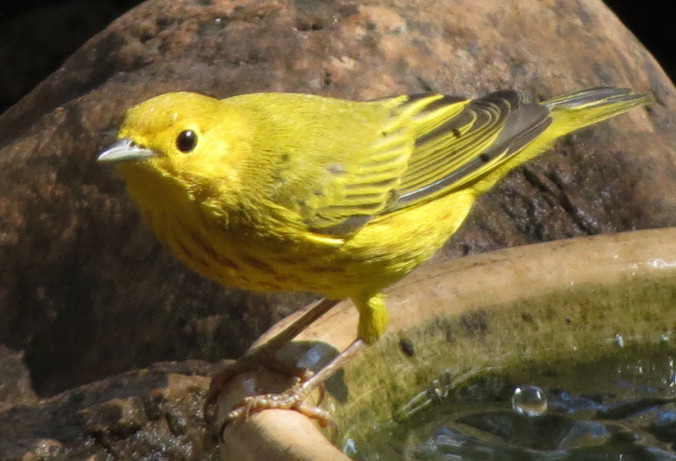
Male Yellow Warbler at our bird bath.
Those streaks are bright red in spring.
Spring is far better than fall for warbler migrants in general. Most of the passage in spring is from mid-April to mid-May. Fall is spread out over almost 3 months and almost never gets the sorts of numbers in a fallout that spring gets. Many of the warblers considered 'eastern' occur here rarely but semi-regularly (less than annually) in spring. The best days are almost always rainy, foggy, drizzly, or showery. The inclement weather precludes migratory progress, grounding them where we might find them.
For spring warbler migration, Nashville Warbler is the only abundant species locally. Yellow-rumped (mostly Myrtle, some Audubon's), and Orange-crowned, might be the next two most numerous, and could qualify as common migrant species. Though they also winter here (just a very few Orange-crowned), big obvious waves of them move through in early spring and in fall. Their migration out of the area in spring is mostly before the main regular migrant warbler passage. As their fall arrival is after the main bulk of other warbler migrant's passage. Then Yellow Warbler is the next most common transient warbler.

Adult male Yellow Warbler in fall, the streaks on underparts
are flaming scarlet red in spring and summer.

A first fall (juv. or imm.) Yellow Warbler.
Wilson's and Black-and-white are 5th and 6th most common and Black-throated Green 7th. Of these 7 species multiples might be found on the best day of passage each spring. After that it gets slim pickens quickly, and nothing could be considered common. Mourning Warbler is regular, a few in spring, more in fall. You can see a few in a day in fall, but a few to several pass through every spring too. Then perhaps Northern Waterthrush is next most regular, a couple or few are seen most spring and fall passage seasons. American Redstart might be the next most regular, but is not a sure thing every spring, and rarer in fall. Those listed above are the top 10 warbler migrants passing through here. Some years there are low numbers of Common Yellowthroat, but other years you might only see one or two during an entire spring or fall migration, and you can even miss it altogether.
This is not migrant warbler heaven, with its low diversity of generally inland or overland migrants. There is no focal point of geographics or habitat (concentration factor). It takes work to see 15 species in a spring. You also need lottsa luck to see 20 species in a spring migration season, and a quarter of those will likely be "only one individual seen" species.

Nashville Warbler is the most common migrant warbler in Utopia or San Antonio for that matter. The nashville is the unit of measurement for warbler migration here. "today warbler movement measured 14 nashvilles, etc." This is a fall immature with pale throat, adults have yellow throats.
The lack of concentration factor, where a billion acres all look the same from the sky, water and trees everywhere, no matter where the bird looks, scatters them. This especially shows in fall when besides Nashville and Yellow Warbler, seeing multiples of almost anything is rare save for Wilson's and Mourning on their best days. Almost anything else is a good bird here in fall. The bulk of the fall passage is in September, by early-to-mid-October it is the last drips of trickle. Besides the departing local nesters (in June-August) and the above mentioned four fall migrants, very few warblers pass through the area (detectably) in fall until late October or November when the Myrtle type Yellow-rumped Warblers arrive. Orange-crowned are never numerous until later in October too.

This is a fall female Yellow Warbler at our bird bath (Aug.).
The bright lines on breast and throat are reflection from
the ripples it just made bobbing down into the water.
Females can be dull almost pale greenish yellow, or very
bright yellow, usually the immatures are the duller ones.

Here is a pair of Yellow Warbler, female facing us, at our bird bath (Aug.).

Just in case you have not seen enough Yellow Warblers yet...
WINTERERS
In winter usually there are 3 species of warblers; Yellow-rumped (Myrtle far far outnumbers Audubon's types ranging 10-20 to 1), a few Orange-crowned, and usually at least a few or some Pine Warbler. The Pine Warbler presence is of great interest because they have never been mapped as a regular winterer here in virtually any field guide. Which reflects the lack of proper winter coverage here over the years, not the species lack of presence. No one ever studied winter passerine flocks on the rivers draining the southern Edwards Plateau. When we moved to San Antonio in '86 it was the same situation even that far east, they were not mapped for wintering there in any guides, but were actually regular in fair numbers. The southwestern corner of Pine Warbler winter range has never yet in history been mapped correctly.
Most winters there will be some Pine Warblers along any drainage corridor with some trees of size, especially at Garner S.P.. But are along all major wooded drainages (Sabinal, Frio, Leona, etc.), usually just a few, but a couple to four in a standard issue winter passerine flock of Myrtle Warbler, E. Bluebirds and Chipping Sparrow (esp. at Garner St. Pk.) is not uncommon. I had 9 in a single flock in and adjacent to our yard winter of 2013-14, a couple miles south of Utopia. One male returned three winters to our yard, during the coldest spells eating millet off the patio, slummin' it with the Chipping Sparrows. Often one or two, some years more, or none, winter in the Utopia Park area. Most warblers are highly insectivorous, and only those that can eat other things like berries, or seeds, can winter northward usually. Here the winter emerging Mayfly is key to their survival.

Orange-crowned Warbler is a dead leaf cluster specialist.
They love 'em. You really have to learn this bird folks
or you will be calling them everything in the book. ;)
This is likely a juvenile (or immature, or young of the year).
Note pale ashy throat, gray head and pale yellow underparts.
Adults usually show yellow throats matching underparts, and
heads are usually more olive matching upperparts (as in pix below).
Several vagrant wintering warblers have occurred recently. First an adult female Black-and-white Warbler wintered for 5 years at Utopia Park. Other than single day CBC records, it was seemingly the first long-term full winter stay, and first returning winterer, documented on the Edwards Plateau. And then it came back four more years. That was pretty good. Another winter Black-and-white was at Lost Maples Jan. 2019 (ph.).
My only winter Parula record is a Tropical at Utopia Park in late January. I have one wintering record of a Yellow-throated Warbler, which of note, is the only one I have ever heard here that sang the typical eastern Yellow-throated Warbler song, so we know it was not from here. Which is spectacular outstanding data if you ask me. Then winter of 2014-15 I found (at Utopia Park) the first documented overwinting Louisiana Waterthrush on the Edwards Plateau. That bird returned two more winters! I have one winter record of a Common Yellowthroat. A male Wilson's Warbler wintered around Utopia Park winter of 2018-19, which might be the first documented overwintering on the plateau. It appears to have returned fall of '19 for a second winter.
Most of the wintering insectivorous passerines here depend on a winter-hatching Mayfly (Ephemeroptera) that is usually numerous along river or creek edges warmer days without wind all winter. The birds are where the hatch is.

Here is the overwintering Wilson's Warbler which was at
Utopia Park Dec. 2018 to March 2019. The orange lores and
forehead indicate one of the western races.
~ ~ ~ ~ ~ ~
Following are a bunch of pics of some of the warblers of Utopia. For the easiest way to see more warblers well, what cannot be overstated is the magnetic factor of the tink, tink, tink, of a drip of water going into a birdbath. It can bring treetop warblers to the ground.

This is a male Golden-winged Warbler, at our birdbath on April 30, 2024. These are very rare here, some (not all) springs one or two get turned up by the army of birders in Uvalde and Bandera Counties in April and May. As of 2002 there was still no UvCo record, and maybe one at Lost Maples. It is also a threatened species in decline. Sylvia Hilbig had one in BanCo May 2012. My only prior sighting was one at the Utopia Park woods... also on April 30 (!), 2021.

Nashville Warbler at our birdbath. The most common migrant warbler here.

Mourning Warbler are actually one of the more regular migrants here,
but are usually only seen one at a time. This is a May female.
One singing male I recorded here was identified as the eastern song type.
It far far outnumbers MacGillivray's, which is accidental in fall
and rare but semi-regular in spring here. Taken through window and screen.
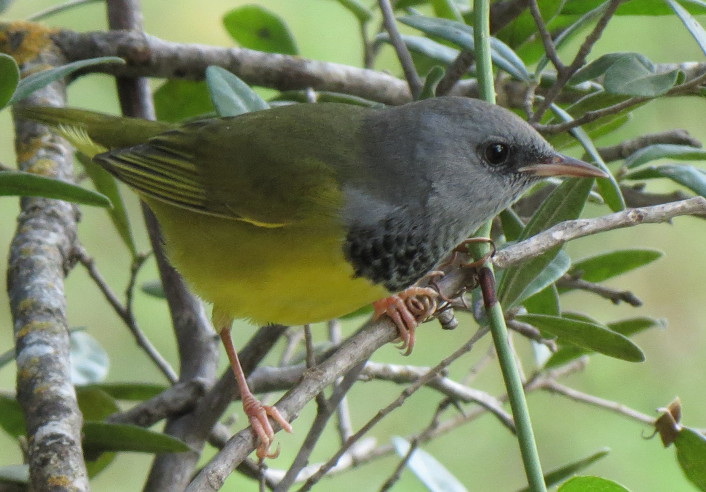
Mourning Warbler, male, September 12, 2019, at front porch.
Mourning Warbler occurs here most often as a fall migrant in September, and most are immatures just a couple months old. They lack the fully hooded look of adults, but enough of it is there to get the idea. They have yellow throats about the color of the belly. The similar but rarer here MacGillivray's Warbler has a whitish to light ashy gray throat as an immature. Mourning females and immatures might show no eyering, a complete eyering, or a broken split eyering. If they have one it is a very fine thin neat clean line.

Mourning Warbler, immature in September.

Another Sept. imm. Mourning Warbler, they usually do not appeared this sort of necklaced with vertical streaks as this bird, which is just molting in the lower part of hood. The gray will fill in across the breast soon, isolating the yellow throat. Note throat and underparts similar in color, yellow.
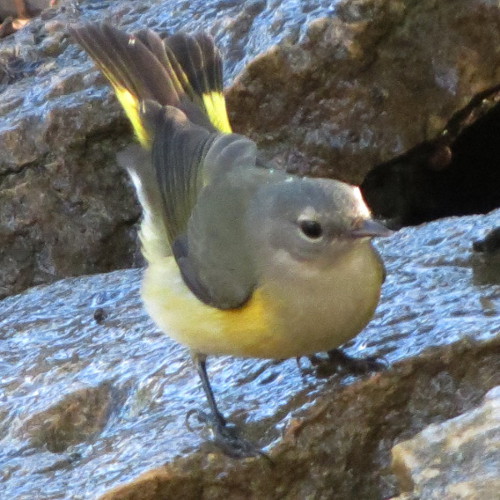
This is a fall immature American Redstart that visited the bath.
They flick and flash the wings and tail incessantly making themselves
really quite showy. Rare in fall, more regular in spring, but easily
missable here any given year. Black and orange-red adult male shown above.

Here is the birdbath showing a little action. Not a warbler on the left, an imm. Dickcissel, on the right a male Wilson's Warbler, and three Yellow Warbler between.

Common Yellowthroat, male, at our birdbath. Sorry about the grainy.
These are usually down low in thick vegetation near water, as along river.
A few pass through every spring and fall. The male is a good looker.
He wouldn't stop flicking his wings and tail, readying for the bath.

Orange-crowned Warbler. Note dusky indistinct streaks on breast.
Especially note face pattern around eye: indistinct dark line through eye,
breaking narrow eyering, and indistinct pale line over eye.

Orange-crowned Warbler - Some are named for the hardest part to see.
Almost all will show the white at the bend of the wing (marginal coverts) as this bird.
The eastern celata subspecies is the type we have here, western orestera is very rare.
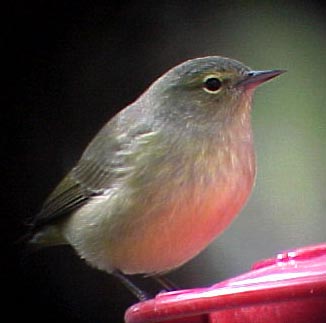
Orange-crowned Warbler will use hummer feeders in winter.
Note face pattern of dark trans-ocular line breaking narrow eye-ring,
with pale line over eye. Note diffuse dusky streaks on breast. The
reddish tones on right half of underparts are an artifact of feeder reflection.

Orange-crowned Warbler foraging for millet during a freeze.
All always show yellow undertail coverts. Tennessee are
pure-as-the-driven-snow white, as in a Golden-cheeked.

Tennessee Warbler showing snow white undertail coverts.
Otherwise superficially very like Orange-crowned. Note
the very short tail, and fine small sharp bill, both very
unlike Orange-crowned Warbler.

Not an Orange-crowned Warbler, but an immature Painted Bunting. Which is what I think almost all August Orange-crowned Warbler reports really are in central Texas. Critically study the bill shape and structure. Note compared to the Orange-crowned Warblers above the plumage is very very similar, green above, dull greenish-yellow below. Without bill shape, an easy mistake to make.

Normally the orange crown feathers are concealed under an outer layer of olive. Your best chance to see it is when they bathe. This is the full monty of orange crown. You can see hundreds over years and not ever see this much orange. On most of them, most of the time, you will not see any orange in crown.


Pine Warbler, adult right, immature left, is regular in low numbers in winter.

The other end of our repeat offender (taken different year).
Mostly present Dec.-Feb., sometimes later Nov. and earliest March.
My what a short primary stack that is.

"Myrtle" form of Yellow-rumped Warbler, mostly in breeding plumage (April).
Warblers are often overhead and this is how you see them.

Prothonotary Warbler
Is it too soon to tell you about warbler neck?
It is a malady of warbler watchers from craning too much.

Black-throated Green Warbler at Lost Maples Oct. 13, 2019.
Missed the ID on the green something going down the hatch.
Note yellow tinge at flanks.

Black-throated Green Warbler, the closest relative of the Golden-cheeked,
occurs mostly as a migrant in spring. It is olive green above, the
full black throat and breast indicates adult male. Some do show an
'upcheck' at rear of dark post-ocular line like Golden-cheek
does, the line always matches upperpart color, e.g., olive, vs. black.
This is a fall Black-throated Green.
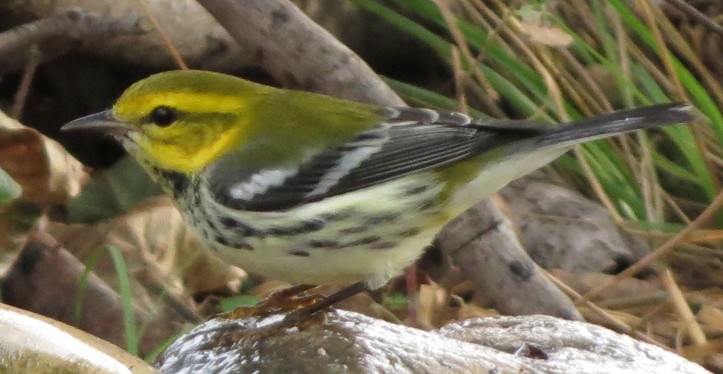
Here is the Black-throated Green Warbler at the bath. They are the
cousins to our endemic breeding Golden-cheeked Warbler, but only occur here
as migrants passing through. Note the tinge of olive-yellow at flank, which
often continues around vent area between legs. All Black-throated greens show
this, Golden-cheeked are snow white throughout posterior underparts, always.
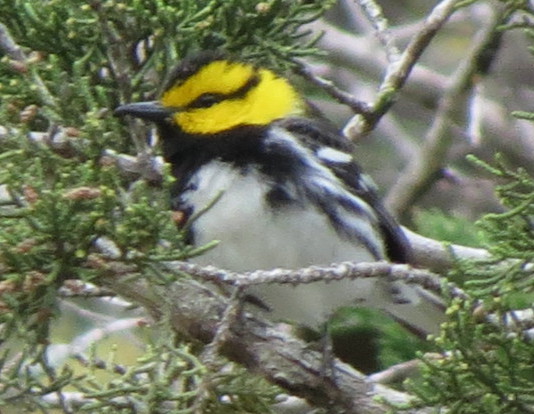
Golden-cheeked Warbler, first spring male.

Golden-cheeked Warbler, first spring male.

Golden-cheeked Warbler male feeding fledgling (taken through telescope from safe distance)


Townsend's Warbler at our bird bath Sept. 25, 2013

This is the adult male Townsend's Warbler Kathy and I found
near HQ at Lost Maples SNA Dec. 2, 2018.

Kentucky Warbler, male at Utopia Park Aug 9-18, 2009.
Accidental in fall in west half of Texas. (taken through binocs)

Everybody's favorite former warbler, that never was a warbler,
Yellow-breasted Chat. This a female, adult male bill is all black,
at least in breeding season when present here.

This is a Black-and-white Warbler, tail not fully grown out, looks fuzzy, probably a juvenile.

Black-and-white Warbler is a bark specialist that works the trunks and large branches of trees.

Rufous-capped Warbler at Concan

Here is a pic Bob Doe got of the Rufous-capped Warbler
I found at Lost Maples (pic on Sept. 29) in 2015. Thanks
Bob for letting us share your great photo!

Wilson's Warbler, Dec. 31, 2018 at Utopia Park.
Nice orange forehead.

Just under a quarter ounce and just over 4" of pure energy,
the Ruby-crowned Kinglet is not a warbler, but often with them in winter.
~ ~ ~ ~ ~ ~ but I digress...
Here it gets real boring with a couple more detailed discussions about a couple of our nesting warblers. There seems to be little understanding of some facets of their lives. Again, there has been very little in the way of long term repeated observation done in the area, which is exciting, because much is unknown, there is much to learn. I will probably chip these off and unto their own pages in the future...
First... about these Yellow-throated Warbler here.
Can we talk? About Yellow-throated Warbler song type here? All across America, found in the entire eastern half, Yellow-throated Warblers sing essentially the same song, a descending Canyon Wren-like clear whistled down scale run: slee slee slee slee slee slee slee slee slee. Sometimes with a high thicker TIK note at the end for flourish. Here, in this westernmost extension of the species range, at least on the Medina, Sabinal, Frio, Nueces and Guadalupe Rivers, they sing a very different song. A lazy modulation between two frequencies, with a very different ending. Some might say tonally more like between a Hooded and Chestnut-sided Warbler, or even a Yellow-rumped Warbler. So quite very unlike all the other Yellow-throated Warblers in the U.S. It is sort of a slow lazy "we see we see we SEE you two", or, "li-lu-li-lu-li-lu-LI-lu-lu", with no chip at the end. No beautiful thinly whistled cascading downscale half-step run. A simple lower-pitched thicker heavier two frequency flatline modulation. Wow.

Yellow-throated Warbler

The line of seperation of this vocally distinct population is a map that has never been drawn. When I asked about it on Texbirds I got a bunch of quizzical stares, apparently no one had noticed these bird's distinct song type here before. I am surprised Oberholser missed this, considering things like Bexar Brown Thrasher, but dead birds don't sing. Some of these Yellow-throated can also show orange on the lower throat. Most often seen and brightest in late spring and early summer. It seems to be acquired by wear, and then wears (molts?) away quickly. I do not know if the other (eastern birds) show this ever or not, I have never seen or heard of it. I have seen it most in later June and earliest July, but a few times earlier in spring. I suspect it is males only, probably older ones. It can be a large squarish orange patch as bright as a Blackburnian, on lower throat to upper breast. I still do not have a photo of it. Have shown it to clients though.
Here Yellow-throated are abundant, territories ca. 200-400 linear feet of river gallery forest, and are edge to edge. It is a Ball Moss (Tillandsia recurvata) specialist, feeding heavilly and nesting in it. Nesting is usually high in the Bald Cypress that line the major rivers, in a clump of ball moss. It does nest away from the river and Cypresses (miles away) but only in live-oak mottes that are heavily infested with Ball Moss. It was not a breeder at Lost Maples in 2000-2007, and virtually accidental then. Since then it has colonized and several pairs are nesting there now since 2012 or so. Up to a dozen singing males may be present in spring the last few years including at least a couple with orange throats. This is a remarkable expansion into an area they absolutely were not using to breed prior. The prime river corridor habitat must be saturated, and producing very well.
... and now on Lousiana Waterthrush...

Louisiana Waterthrush, juvenile

Louisiana Waterthrush, adult

Louisiana Waterthrush, adult
One last chip note, on Louisiana Waterthrush identification and status here. Some field guides stress or tout the pink buff flanks and two-toned (bicolored) eye-line as being critical to ID it. Note in the two above photos, perhaps closer than the average field view, these things are not apparent. Such is often if not typically the case here in spring to early summer. Not all Lousiana show the buffy flank color in late spring to early summer, as it wears off over winter, causing many mis-identified reports of Northern Waterthrush at Lost Maples in spring due to lack of buffy flanks. Buffy flanks go from absent in late spring and early summer, to boldly apparent in late summer when they complete pre-basic molt around late July or August usually.
Also note contrary to some published accounts (Dunn and Garrett Peterson Warbler Field Guide), any Louisiana Waterthrush after early Sept. does not need documentation here. In fact in early Septmember here at say Lost Maples, or Big Springs above Leakey, I want proof you saw a Northern. Which does occur, but is not much more likely is the point. Labor Day weekend is about when the first Northerns show up, but Louisiana can still be present, and Northern are scarce here in fall. Regular, but scarce.
Louisiana have been detected present and singing into September locally. Tony Gallucci had them one year on Nature Quest at Big Springs singing on Sept 15 still, and another year on a NQ walk he and I had it singing there on Sept. 21. So, many elsewhere may have left there territories by early Sept., and some of these do too, but some of these can still nesting be again in August, and at mid-September can sometimes be still singing on territory. Migrant Louisiana probably from further north can also occur in September.
Below is another example of Louisiana Waterthrush here past early September, this one wintered at Utopia Park. Frankly a wintering waterthrush here on plateau seems more likely to be Louisiana than Northern. I heard of a prior report of them in winter but it was not a photographed record so few believed it is my take on it.

Apparently the first ever documented over-wintering Louisiana Waterthrush on the Edwards Plateau, present at Utopia Park from early December (at least) 2014 to early March, 2015. This image acquired Jan. 25, 2015. It returned for the winter of 2015-2016, and returned again for winter of 2016-17 but was last seen at end of December.
SUMMARY
So there is fair warbler diversity here considering the situation. It makes up for lack of diversity with a spectacular breeding endemic that is here only 120 days of the year, or so. There are almost always some type of warblers around to be seen, in any season. You have to work at it to see a lot of them. Especially the migrants which are moving through fast and often only briefly grounded due to a weather event. In spring work the bloom. Whichever trees are in flower is where the migrants will be. In all seasons work the water. Learn songs, the chip notes, and undertail patterns. A drip at a bath is a great way to see them close in your yard as you can see from many of the photos here. It will bring them down out of the treetops, along with lots of other cool stuff. Bird baths must be near protective cover for them to approach, and dive into. Near dense bushy shrubs is best.

Have a Nash day!

The End
If you have arrived here from our Bird Photos page, you may close your browser to return to the Bird Photos index.
Other visitors may click your "Back" button on your browser or select a link to keep visiting!

To Bird Photo Main Menu

To Butterfly Pics

To Dragonfly & Damselfly Pics

To Current Bird News
Birds
Utopia Birds
Birding Sites
Bird List
Bird Guide
Reports from Lost Maples
Winter Bird Count
Butterflies
Butterfly News
Butterfly List
Butterfly Photos
Rare Butterflies
Dragonflies
Critters, Bugs, & Stuff
Lost Maples
Garner State Park
Local Site Guide
Home

Our E-mail
mitch @ utopianature.com
 All photographs within this site are copyrighted
All photographs within this site are copyrighted